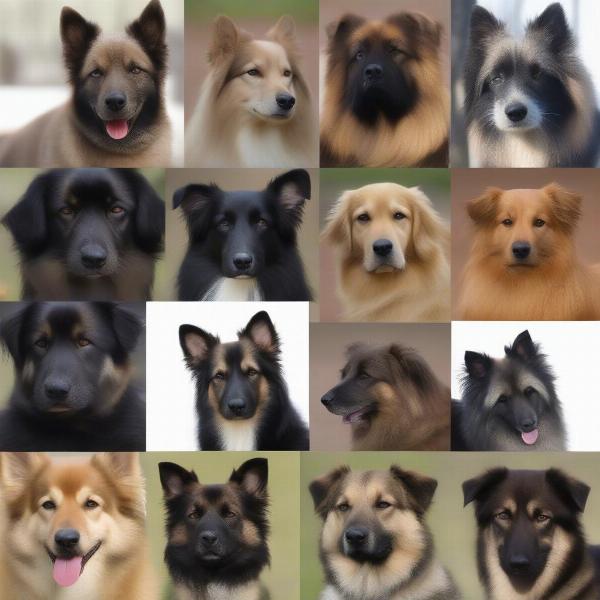The sable colour in dogs is a fascinating and often misunderstood coat pattern. It’s not a specific breed, but rather a description of how pigments are distributed throughout the fur, creating a distinctive look. If you’re curious about the sable dog colour, this article will delve into its genetics, variations, and the breeds that commonly sport this beautiful coat.
Sable colouring occurs when each individual hair has multiple bands of colour, typically with a darker tip. The base of the hair can be a lighter colour, such as cream, gold, or tan, while the tips are often black, brown, or grey. This creates a layered effect, giving the coat depth and dimension. The intensity and distribution of the sable colouring can vary greatly, resulting in a wide range of appearances even within the same breed. Some dogs have a clear sable pattern, while others appear almost solid-coloured due to heavy tipping. The sable colour is often described as having a grizzled or shaded appearance.
Decoding the Genetics of Sable Dog Colour
The sable colour is determined by the interaction of several genes, primarily the Agouti gene (A locus). This gene controls the distribution of pigment in the hair shaft. The specific allele responsible for the sable pattern is often referred to as Ay. The intensity and pattern of the sable are further influenced by other modifier genes, making it a complex trait. These modifier genes can affect the length and distribution of the dark tipping, resulting in various shades and patterns.  Different Sable Colour Variations in Dogs
Different Sable Colour Variations in Dogs
Breeds Commonly Displaying the Sable Colour
While the sable colour can appear in many breeds, it is particularly prevalent in certain breeds like German Shepherds, Shetland Sheepdogs, Collies, and Siberian Huskies. In German Shepherds, sable is a highly sought-after colour variation, often associated with working lines. Shelties can exhibit a wide range of sable shades, from light golden sable to mahogany sable. Collies often display a rich, deep sable with distinct banding, while Siberian Huskies can have a more subtle sable pattern with grey or black tipping.
Caring for a Sable Dog’s Coat
Caring for a sable coat is similar to caring for other coat types. Regular brushing helps to remove loose hair and prevent matting. The frequency of brushing depends on the length and density of the coat. Bathing should be done only when necessary, using a dog-specific shampoo to avoid stripping the natural oils.
Common Misconceptions about Sable Dogs
One common misconception is that sable dogs are a separate breed. As we’ve discussed, sable is a colour pattern, not a breed itself. Another misconception is that sable coats require special grooming products. While using high-quality dog shampoo and conditioner is recommended, specific “sable” products are usually unnecessary.
Conclusion
The sable colour in dogs is a beautiful and complex trait, resulting from a fascinating interplay of genetics. From the rich, shaded tones of a German Shepherd to the lighter, more subtle patterns seen in some Huskies, sable dogs captivate with their diverse appearances. Understanding the genetics and variations of the sable colour allows us to appreciate the unique beauty of each individual dog. Remember, whether a clear sable or heavily tipped, each variation adds to the charm and individuality of these wonderful canines. sable dog colour
- What is the sable colour in dogs? Sable is a coat pattern where each hair has multiple bands of colour, typically with a darker tip, creating a layered effect.
- Which breeds commonly have sable coats? Breeds like German Shepherds, Shetland Sheepdogs, Collies, and Siberian Huskies often display sable coats.
- Is sable a breed of dog? No, sable is a coat colour, not a breed.
- Does a sable coat require special grooming? No, regular brushing and occasional bathing with dog-specific shampoo are sufficient.
- What determines the sable colour? The Agouti gene (A locus) primarily determines the sable pattern.
- Are all sable coats the same? No, the intensity and pattern of sable can vary greatly due to modifier genes.
- What are some variations of sable? Variations include clear sable, tipped sable, shaded sable, and more.
ILM Dog is your trusted partner in providing comprehensive information and expert guidance on all aspects of dog care. From breed selection to health and nutrition, training and behaviour, to products and accessories, we offer a wealth of knowledge to help you navigate the rewarding journey of dog ownership. We also have helpful articles on topics such as hunstanton dog friendly beach and dog collars and leads uk. Whether you’re a seasoned dog owner or just starting out, ILM Dog is here to support you every step of the way. Contact us at [email protected] or +44 20-3965-8624 for personalized advice or explore our website for more valuable resources. Read more about helpful products like the banded dog vest or a personalised dog blanket .